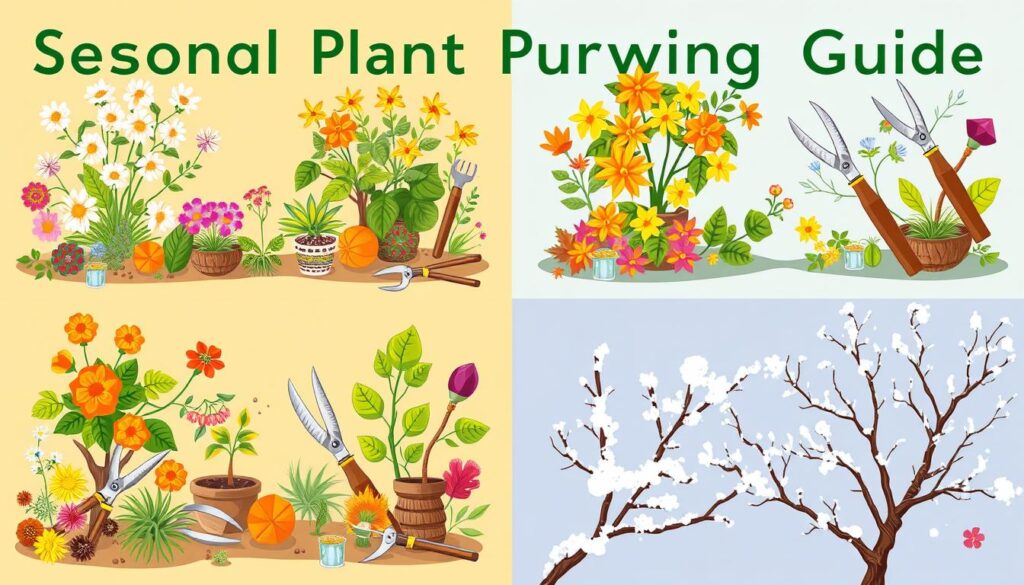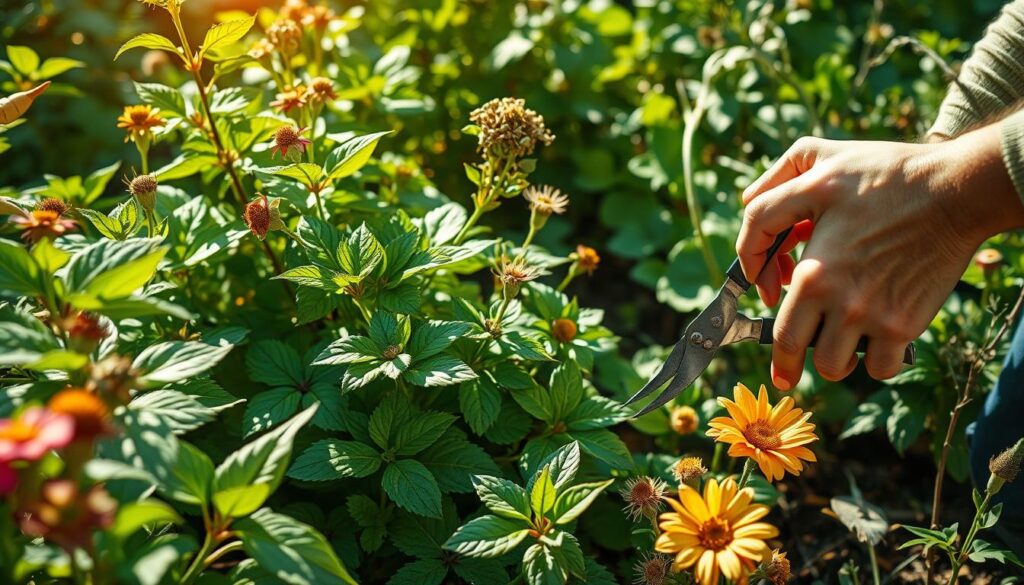Ever wondered why some gardens do better than others? The answer often lies in the pruning techniques used. This guide will show you how to prune plants right, making them healthier and more beautiful. You’ll see how a few cuts can make a big difference in your garden’s look.
Let’s dive into the world of plant pruning. We’ll explore the techniques that make your garden stand out. You’ll learn how to make your plants thrive, turning your garden into a vibrant oasis.
Key Takeaways
- Effective pruning is crucial for maintaining plant health.
- Understanding different pruning techniques can boost growth and flowering.
- The right timing for pruning can significantly influence outcomes.
- Utilizing specialized tools enhances the pruning process.
- A personalized pruning schedule helps track progress and improve results.
- Common mistakes in pruning can hinder plant development.
- Pruning plays a vital role in disease management and pest control.
Understanding the Importance of Pruning
To have a thriving garden, knowing how to prune plants is key. Pruning helps plants stay healthy and look great. It makes them stronger and more beautiful.
Benefits of Pruning for Plant Health
Pruning helps plants breathe better by removing dead or sick branches. This stops diseases from spreading. Healthy plants are less likely to attract pests, making your garden better.
How Pruning Influences Growth and Flowering
Pruning encourages plants to grow stronger and bloom more. It helps them focus on making better branches and flowers. This leads to a garden full of life and color.
Timing Your Pruning for Optimal Results
Knowing when to prune is as important as how. Each plant needs pruning at a specific time for the best results. Using the right pruning tips helps plants grow and bloom all year.
| Pruning Timing | Best Practices | Recommended Plants |
|---|---|---|
| Spring | Remove dead or damaged growth | Roses, Shrubs |
| Summer | Shape and control growth | Fruit Trees, Perennials |
| Fall | Prepare plants for dormancy | Trees, Evergreens |
| Winter | Perform structural pruning | Deciduous trees |
Types of Pruning Techniques Explained
Learning about different pruning techniques can really help your plants. Each method has its own purpose. They all work together to keep your plants healthy and looking good. Here are three key techniques to know, each important for pruning plants well.
Crown Thinning: Enhancing Light Penetration
Crown thinning means removing some branches to let more light in. This helps lower branches grow better and flower more. It’s great for deciduous trees, helping them keep their shape and supporting plants below.
Heading Cuts: Shaping and Controlling Growth
Heading cuts help shape plants and control their size. You cut branches back to a bud, which makes them bushier and more flowerful. This is often used on shrubs and hedges, making them easier to care for and look better.
Rejuvenation Pruning: Renewing Old Plants
Rejuvenation pruning gives old plants a new lease on life. It involves cutting back overgrown or damaged branches to spark new growth. This way, gardeners can keep perennials and shrubs healthy and thriving.
Tools Every Pruner Should Have
Having the right pruning tools is key for effective pruning. This section looks at essential tools and how to use them well.
Essential Pruning Shears and Their Uses
Pruning shears are a must-have for any pruner. They cut through small stems and branches, helping plants grow back strong. There are a few types to choose from:
- Bypass Shears: Great for delicate plants, they make precise cuts.
- Anvil Shears: Good for thicker branches, they have more power.
Picking the right shears for your plants is important for their care.
Specialty Tools for Unique Plant Species
Some plants need special tools for pruning. Here are a few examples:
- Loppers: Long-handled tools for cutting thicker branches.
- Pruning Saws: For cutting large limbs that shears can’t handle.
- Topiary Shears: For shaping shrubs and hedges.
Using the right tools for each plant is vital for their health.
Maintenance of Pruning Tools for Longevity
To keep your pruning tools in good shape, regular care is needed. Clean and oil them to prevent rust and keep them sharp. Store them in a dry place to avoid damage from moisture. Taking good care of your tools means they’ll last longer, helping you keep your plants healthy.
Seasonal Pruning Guide
Knowing when to prune plants is key for any gardener. Each season has its own needs and challenges. The right timing and methods are crucial for healthy plants.
Spring Pruning: Preparing for Growth
Spring is all about new beginnings and growth. It’s the best time to prune. Remove deadwood and weak branches to encourage strong growth.
Summer Pruning: Fine-tuning Your Plants
In summer, pruning focuses on shaping. Trim back overgrown parts to keep the plant balanced. This helps in maintaining its form and promoting blooms.
Fall and Winter Pruning: Dormant Care
When plants are dormant in fall and winter, pruning is vital. It helps them recover and grow stronger in spring. Pruning during these months prepares plants for cold weather.

Pruning Trees vs. Shrubs: Key Differences
Knowing how trees and shrubs grow is key to good pruning. Trees have one main trunk and branches that spread out. Shrubs grow many stems close to the ground. This means you need to prune them differently to keep them healthy and looking good.
Understanding Growth Habits of Trees
Trees grow slower than shrubs and have bigger leaves. Pruning trees should focus on keeping their shape and strong branches. It’s important to prune trees when they’re young and avoid big cuts on older trees. Also, make sure trees get enough air and light.
Best Practices for Shrub Pruning
Shrubs can handle more pruning than trees. Cutting them right can make them bushy and full of flowers. Here are some tips for *shrub pruning*:
- Know what kind of shrub you have and how it likes to grow.
- Prune after they bloom if they flower on last year’s wood.
- Use the right pruning methods to keep your shrubs looking good.
Common Pruning Mistakes to Avoid
Knowing common pruning mistakes is key to a healthy garden. Using the right pruning techniques boosts plant health. But, making errors can harm your plants. Learning what to avoid helps gardeners keep their plants thriving.
Pruning Techniques for Specific Plant Types
Different plants need different pruning methods to grow well. Gardeners use expert techniques to care for each plant type. This ensures gardens are full of life and beauty.
Roses: Techniques for Healthy Blooms
Roses are famous for their beauty and smell. They need the right pruning to bloom well. Here are some tips:
- Remove any crossing branches to promote better airflow.
- Cut stems at a 45-degree angle, right above a leaf node.
- Thin out the center to allow light penetration.
Fruit Trees: Maximizing Yield Through Pruning
Pruning is key to getting more fruit from trees. For apple and peach trees, try these:
- Thinning out crowded branches to improve sunlight exposure.
- Cutting back vigorous shoots that compete for vitality.
- Shaping the tree to facilitate easier harvesting and access.
Perennials: Seasonal Care and Pruning Needs
Perennials grow back every year. Knowing their needs is important. Here’s how to care for them:
- Cutting back spent blooms in late summer to encourage another wave of flowers.
- Dividing over-crowded plants every few years to promote healthy growth.
- Adjusting pruning techniques based on weather conditions and plant health.
Best Practices for Pruning Climbers and Vines
Pruning climbers and vines needs a good understanding of their growth. Using the right plant care pruning methods can make these plants healthier and more beautiful. Here are some tips for pruning vining plants.
Identifying Growth Patterns in Vining Plants
It’s important to watch how the plant grows before you start pruning. Vining plants can be divided into two types. Some bloom on new growth, while others bloom on old wood. Knowing this helps you prune them right, so they grow well and bloom beautifully.
Also, notice how the plant climbs. Does it use tendrils, twining stems, or adhesive pads?
When to Prune for Optimal Growth
The best time to prune depends on the vine type. Spring is usually the best time for many climbers, as they grow fast then. For others, prune right after they bloom to keep them flowering.
Knowing when to prune is key to good plant care.
Techniques for Maintaining Shape and Health
Keeping climbing plants in shape and healthy is vital for a great vertical garden. Use selective pruning to keep the shape right. Also, cut out dead or damaged wood to promote healthy growth.
By following these pruning tips, your garden will look lush and beautiful.
The Role of Pruning in Disease Management
Pruning is key in keeping plants healthy. It stops diseases from spreading by cutting off infected parts. Knowing how to spot and remove these areas is crucial for a strong garden.
Identifying Diseased or Damaged Branches
Regular checks on your plants can reveal disease signs. Look for:
- Discoloration
- Wilting leaves
- Strange growths or swellings
- Dead or brittle branches
Removing these branches early stops more damage. This keeps your plants strong and your garden healthy.
Pruning Techniques to Enhance Airflow
Pruning makes plants breathe better by opening up their leaves. This reduces moisture, which fights off fungi. It’s great for plants that are too close together.
Try these pruning tips:
- Crown thinning to reduce density
- Selective pruning to open up the canopy
- Cutting back excess growth
These methods make plants stronger and less prone to disease.
How Pruning Affects Pest Control
Pruning also fights pests by keeping plants healthy. It weakens pests by removing their food sources. This makes plants less attractive to pests, making care easier.

Creating a Pruning Schedule for Your Garden
Creating a successful garden is more than just planting and watering. It’s also about having a pruning schedule. This schedule helps you know when and how to prune different plants. It ensures your garden grows healthy and looks great.
Developing a Personal Pruning Calendar
Start by making a list of all your garden plants and their pruning needs. Different plants need different care based on their growth and when they bloom. Use a seasonal guide to find the best times to prune each plant.
Factors to Consider When Scheduling
When making your pruning schedule, think about the climate, plant type, and local growth patterns. Some plants need more pruning than others. Also, consider when plants are dormant. This way, you can give each plant the right care at the right time.
Tracking Progress to Improve Techniques
Keep track of your pruning and how it affects your plants. Note how they react to different pruning times and methods. This helps you improve your pruning skills and make your garden even healthier and more vibrant.
FAQ
What are the expert plant pruning techniques I should know?
Key pruning techniques include crown thinning for better light, heading cuts for shaping, and rejuvenation pruning for older plants. These methods ensure healthy growth and a great look.
Why is proper plant pruning important?
Proper pruning boosts plant health by removing dead or diseased parts. It also improves air circulation and encourages strong growth and flowers. This leads to beautiful, thriving plants.
When is the best time for seasonal plant pruning?
The best pruning time varies by plant type. Spring is great for preparing for growth. Summer is for light trimming. Fall or winter is best for pruning during dormancy to protect plants.
What tools do I need for effective pruning?
You’ll need pruning shears, loppers, and saws. Each tool is for different plants. Choosing the right tools is key for good plant care.
How can I avoid common pruning mistakes?
To avoid mistakes, know your plants’ needs. Don’t over-prune, as it weakens plants. Also, prune at the right time to avoid harming growth.
Are there special pruning techniques for roses?
Yes, roses need special care. Cut back old wood for new growth and ensure open centers for air. This leads to healthy blooms and strong plants.
What is the role of pruning in disease management?
Pruning is key in fighting diseases by removing sick branches. It also helps with airflow, reducing disease risk. This keeps plants healthy.
How do I create a pruning schedule for my garden?
Make a pruning schedule based on your plants, their growth, and the seasons. A personalized calendar ensures timely care and better pruning.


